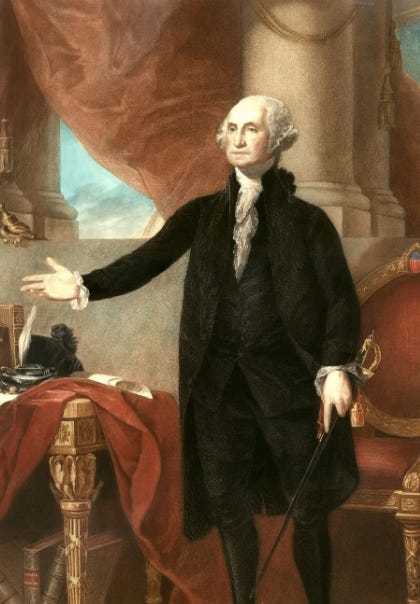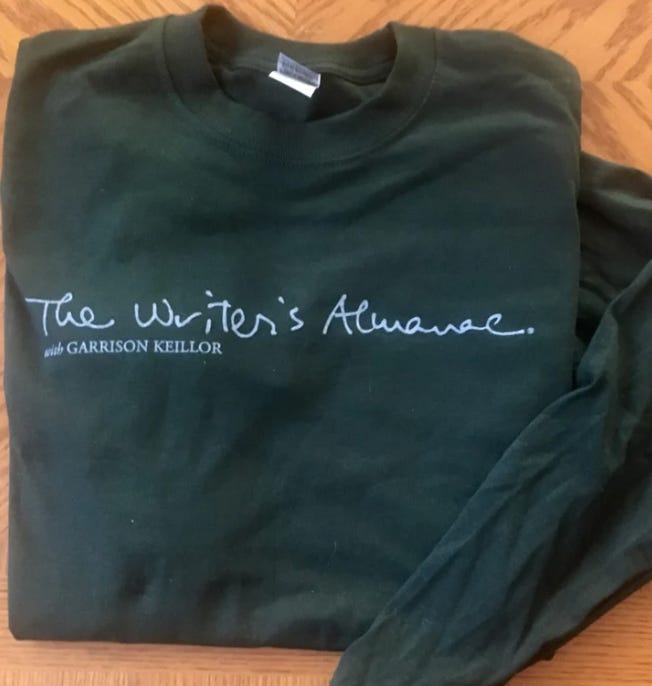“Taking Down the Tree” by Jane Kenyon from Collected Poems. © Graywolf Press, 2005.
ORIGINAL TEXT AND AUDIO - 2017
George Washington delivered the first State of the Union address on this date in 1790. He delivered the address in New York City, which was the nation’s provisional capital at that time. He spoke to both houses of Congress in a joint session, spelling out his agenda for the coming year. He talked about the usual topics: immigration, border security, overseas trade, and adequate funding for national defense; he also urged Congress to promote science and literature, saying, “Knowledge is in every country the surest basis of public happiness.” He closed by saying, “The welfare of our country is the great object to which our cares and efforts ought to be directed, and I shall derive great satisfaction from a cooperation with you in the pleasing though arduous task of insuring to our fellow citizens the blessings which they have a right to expect from a free, efficient, and equal government.”
We owe our current State of the Union tradition to Washington, but there was a long stretch of time where the president did not give the address in person. Thomas Jefferson broke with precedent in 1801 because he felt it was too similar to the British monarch’s Speech from the Throne. He wrote out his address instead, and sent it to Congress, where it was read by a clerk. Jefferson’s tradition was continued until 1913, when Woodrow Wilson decided to address Congress in person once more, and though there have been exceptions since then, a personal address has become the standard method of delivery. Until Calvin Coolidge broadcast his address to Congress over the radio in 1923, the public had to wait to read the president’s words in the newspapers. Franklin Roosevelt was the first president to actually call it the “State of the Union Address” — prior to that, it had been known as the President’s Annual Address to Congress — and Harry S. Truman was the first president to give a televised address.
Today is the birthday of British naturalist and biologist Alfred Russel Wallace, born in the Welsh village of Llanbadoc (1823). He didn’t come from a wealthy family, and he had only six years of formal education, but he came up with a theory of natural selection that predates Charles Darwin’s. After he left grammar school, he read his way through his family’s extensive library, and then moved to London to live with his older brother, an apprentice carpenter, when he was 14. In London, he was able to attend lectures and pursue his own education. He also became an apprentice surveyor. He worked in rural areas of England and Wales for several years, surveying land for the General Enclosures Act, which allowed for the division of public lands among landowners. As part of his work, he met many small farmers whose way of life was being destroyed by the Enclosures Act. He wrote down as many details as he could, and later incorporated them into an essay called “The South Wales Farmer.” He remained deeply concerned with social issues for the rest of his life.
Wallace’s time spent outdoors as a surveyor sparked an interest in the natural world. He made friends with an entomologist named Henry Walter Bates, who introduced him to insect collecting. The two formed a plan to travel to South America and collect insect specimens, both for their own use and also to sell to English museums to finance their expedition. It was a great plan, and they were able to send off one shipment to London, but on the journey home Wallace’s ship sank and Wallace lost the rest of his collection and most of his notes. He was still able to publish several articles, a map, and two books (Palm Trees of the Amazon and Their Uses and Narrative of Travels on the Amazon and Rio Negro, both 1853).
Wallace’s Amazon publications earned him respect as well as money, and the Royal Geographical Society sent him to the Malay Archipelago, where he lived and worked for eight years. He noticed that there seemed to be a kind of division or line: on the west side of this line, the animal life was similar to that found in Asia, and on the east side of the line, it had more in common with the fauna of Australasia. That observation led to his work in the geographic distribution of animal species. The dividing line has come to be known as the Wallace Line, in his honor.
It was also in the Malay Archipelago that he first came up with his theory of natural selection. He had read Charles Darwin’s journal, The Voyage of the Beagle (1839), and he thought Darwin might be interested in his theory, so he wrote to him in 1858. Darwin had been forming his own thoughts about natural selection too, and he published a paper — giving Wallace co-credit — called “On the Tendency of Species to Form Varieties; and on the Perpetuation of Varieties and Species by Natural Means of Selection” (1858). Darwin remained a great admirer of Wallace and his work for the rest of their lives.
But Darwin was from a rich family, and Wallace wasn’t. Darwin could weather the ups and downs of his career by falling back on his family’s wealth. Wallace tried several times to find an academic post back in England, but was never able to, and a series of bad investments cost him his savings. He made a little money grading school exams, and wrote a popular book called The Malay Archipelago: The Land of the Orang-Utan, and the Bird of Paradise (1869), but his financial outlook was not secure until Darwin and T.H. Huxley lobbied on his behalf for a government pension in recognition of his scientific contributions. He received 200 pounds a year for the rest of his life, and died at the age of 91.
Great Britain began wartime food rationing on this date in 1940. Every person was issued a ration book, and they would use the coupons inside to buy limited quantities of hard-to-obtain items like butter, sugar, and eggs.
At the beginning, the rations per person, per week, were as follows: 4 ounces of butter; 12 ounces of sugar; 4 ounces of raw bacon or ham; 3.5 ounces of cooked bacon or ham; and 2 eggs. As the war dragged on, other meats, bread, tea, and clothing were rationed as well. Children aged five and older had their own books; children younger than five were expected to share their parents’ rations. Often mothers of young children would find that extra food had been slipped into their shopping bags by the shopkeepers, free of charge.
Rationing continued for several years after the war, finally ending in 1954.
And it’s the birthday of Elvis Presley, born in Tupelo, Mississippi (1935). His first stage performance came in 1945, when he was 10 years old. He sang “Old Shep” at a talent contest, and came in fifth, winning five dollars’ worth of ride tickets for the Mississippi-Alabama fair. The following year, he wanted a bicycle, but his parents were too poor to buy one. His mother, Gladys, talked him into accepting a substitute gift: a guitar, which cost $12.95 at the Tupelo Hardware Company.
The family moved to Memphis when Presley was 13, and he grew up in public housing and listening to Memphis R&B. These, along with Tennessee country music that he heard on the radio, were his musical roots. When he was 18, working as a truck driver, he wanted to give his mom a gift, so he stopped by the Memphis Recording Service, where you could record your own songs for a small fee. He had $4, and with that money he was able to record two songs: “My Happiness” and “That’s When Your Heartaches Begin.” The Memphis Recording Service was also the home of Sun Records, and Elvis caught the attention of owner Sam Phillips, who called the young truck driver back in to see what other songs he knew, and that was the beginning of his career.
Be well, do good work, and keep in touch.®






Charles Darwin wrote two unpublished essays on his theory of natural selection in 1842 and 1844, and came to the concept in the late 1830s. This was long before Alfred Wallace also developed a similar theory of natural selection in the late 1850s.
Gilbert Klapper, paleontologist at Northwestern University